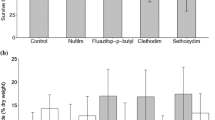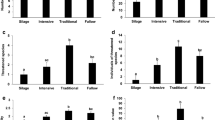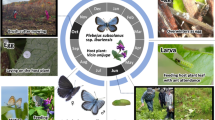Abstract
Selective herbicides are a conservation tool employed to reduce invasive vegetation and improve habitat for native plants and animals. However, herbicides may negatively affect non-target organisms such as butterflies through direct chemical exposure or by altering plant community composition and structure. We evaluate the effect of the grass-specific herbicide fluazifop-p-butyl on behavior and demographic responses of the silvery blue butterfly (Glaucopsyche lygdamus) in the field and also quantify effects on reproductive behavior in the greenhouse. We find that in the first few months after an early spring application, herbicide decreases vertical grass structure but does not have a positive or negative net effect on adult behavior, egg deposition, larval density, pupal weight, or ant-tending association for the silvery blue. Our greenhouse oviposition choice trials corroborate field findings and indicate that females do not show preference for unsprayed host plants. Selective herbicides create a vegetative structure preferred by butterflies and do not negatively affect the silvery blue when applied in the early spring. Appropriate timing of herbicide application is likely the key to avoiding adverse effects on vulnerable butterfly life stages. Depending on the longevity of the vegetative reduction, strategic herbicide application may be useful for restoring prairie communities in concert with other restoration tools; however, further testing on additional butterfly species is an imperative precursor to large-scale spraying.





Similar content being viewed by others
References
Agnello AM, Bradley JR, Van Duyn JW (1986a) Plant-mediated effects of postemergence herbicides on Epilachna varivestis (Coleoptera: Coccinellidae). Environ Entomol 15:216–220
Agnello AM, VanDuyn JW, Bradley JR (1986b) Influence of postemergence herbicides on populations of bean leaf beetle, Cerotoma trifurcata (Coleoptera: Chysomelidae), and corn earworm, Heliothis zea (Lepidoptera: Noctuidae), in soybeans. J Econ Entomol 79:261–265
Barton K (2013) MuMIn: multi-model inference. R package version 1.9.13
Bates DM, Maechler M, Bolker B, Walker S (2013) lme4: linear mixed-effects models using Eigen and S4. R package version 1.0-4
Blake RJ, Woodcock BA, Westbury DB, Sutton P, Potts SF (2011) New tools to boost butterfly habitat quality in existing grass buffer strips. J Insect Conserv 15:221–232
Blakeley-Smith MR (2006) Performance of Willamette valley native plants following herbicide exposure. M.S. Thesis, Oregon State University
Bolker BM, Brooks ME, Clark CJ, Geange SW, Poulsen JR, Henry M, Stevens H, White JS (2009) Generalized linear mixed models: a practical guide for ecology and evolution. Trends Ecol Evol 24:127–135
Bramble WC, Yahner RH, Byrnes WR (1999) Effect of herbicide maintenance of an electric transmission line right-of-way on butterfly populations. J Arboric 25:302–310
Brust GE (1990) Direct and indirect effects of four herbicides on the activity of carabid beetles (coleoptera: Carabidae). Pestic Sci 30:309–320
Burnham KP, Anderson DR (2002) Model selection and multimodel inference: a practical information-theoretic approach, 2nd edn. Springer-Verlag, New York
Chakravarty P, Chatarpaul L (1990) Non-target effect of herbicides: II. The influence of glyphosate on ectomycorrhizal symbiosis of red pine (Pinus resinosa) under greenhouse and field conditions. Pestic Sci 28:243–247
Chiverton PA, Sotherton NW (1991) The effects of beneficial arthropods of the exclusion of herbicides from cereal crop edges. J Appl Ecol 28:1027–1039
Crone EE, Marler M, Pearson DE (2009) Non-target effects of broadleaf herbicide on a native perennial forb: a demographic framework for assessing and minimizing impacts. J Appl Ecol 46:673–682
Dennehy C, Alverson ER, Anderson HE, Clements DR, Gilbert R, Kaye TN (2011) Management strategies for invasive plants in Pacific Northwest prairies, savannas, and oak woodlands. Northwest Sci 85:329–351
Dunwiddie P, Delvin E (2006) Preliminary prairie restoration study finds sethoxydim reduces exotics without harming natives (Washington). Ecol Restor 24:54
Eichel S, Fartmann T (2008) Management of calcareous grasslands for Nickerl’s fritillary (Melitaea aurelia) has to consider habitat requirements of the immature stages, isolation, and patch area. J Insect Conserv 12:677–688
Eliyahu D, Applebaum S, Rafaeli A (2003) Moth sex-pheromone biosynthesis is inhibited by the herbicide diclofop. Pestic Biochem Physiol 77:75–81
El-Metwally IM, Shaiby EM (2007) Bio-remedaition of fluazifop-p-butyl herbicide contaminated soil with special reference to efficacy of some weed control treatments in faba bean plants. Res J Agric Biol Sci 3(3):157–165
Feber RE, Smith H, MacDonald DW (1996) The effects on butterfly abundance of the management of uncropped edges of arable fields. J Appl Ecol 33:1191–1205
Fiedler K (1991) Systematic, evolutionary, and ecological implications of myrmecophily within the Lycaenidae (Insecta: Lepidoptera: Papilionoidea). Bonn Zool Monogr 31:1–211
Freemark K, Boutin C (1995) Impacts of agricultural herbicide use on terrestrial wildlife in temperate landscapes: a review with special reference to North America. Agric Ecosyst Environ 52:67–91
Fuhlendorf SD, Engle DM, Arnold DC, Bidwell TG (2002) Influence of herbicide application on forb and arthropod communities of North American tallgrass prairies. Agric Ecosyst Environ 92:251–259
Gelman et al (2004) Bayesian data analysis, 2nd edn. Chapman & Hall, London
Grueber CE, Nakagawa S, Laws RJ, Jamieson IG (2011) Multimodel inference in ecology and evolution: challenges and solutions. J Evol Biol 24:699–711
Haughton AJ et al (2001a) The effect of the herbicide glyphosate on non-target spiders: part I. Direct effects on Lepthyphantes tenuis under laboratory conditions. Pest Manag Sci 57:1033–1036
Haughton AJ, Bell JR, Boatman ND, Wilcox A (2001b) The effect of the herbicide glyphosate on non-target spiders: part II. Indirect effects on Lepthyphantes tenuis in field margins. Pest Manag Sci 57:1037–1042
Hawes C, Haughton AJ, Osborne JL, Roy DB, Clark SJ, Perry JN et al (2003) Responses of plants and invertebrate trophic groups to contrasting herbicide regimes in the farm scale evaluations of genetically modified herbicide-tolerant crops. Philos Trans Roy Soc B Biol Sci 358:1899–1913
Henry EH, Schultz CB (2012) A first step towards successful conservation: understanding local oviposition site selection of an imperiled butterfly, Mardon Skipper. J Insect Conserv 17:183–194
Hidayat I, Preston C (1997) Enhanced metabolism of fluazifop acid in a biotype of Digitaria sanguinalis resistant to the herbicide fluazifop-p-butyl. Pestic Biochem Physiol 57:137–146
Isaac NJB, Cruickshanks KL, Weddle AM, Rowcliffe JM, Brereton TM, Dennis RLH, Shuker DM, Thomas CD (2011) Distance sampling and the challenge of monitoring butterfly populations: distance sampling and monitoring butterflies. Methods Ecol Evol 2:585–594
Karlsson B (1994) Feeding habits and change of body composition with age in three Nymphalid butterfly species. Oikos 69:224–230
Kohler HR, Triebskorn R (2013) Wildlife ecotoxicology of pesticides: can we track effects to the population level and beyond? Science 341:759–765
Kulshrestha G, Singh SB, Gautam KC (1995) Residues of fluazifop-p-butyl following application to soybean. Bull Environ Contam Toxicol 55:276–282
LaBar CC, Schultz CB (2012) Investigating the role of herbicides in controlling invasive grasses in prairie habitats: effects on non-target butterflies. Nat Area J 32:177–189
Langston RL (1969) A review of Glaucopsyche, the silvery blues, in California (Lycaenidae). J Lepid Soc 23:149–154
Lavoie B, Oberhauser KS (2004) Compensatory feeding in Danaus plexippus (Lepidoptera: Nymphalidae) in response to variation in host plant quality. Environ Entomol 33:1062–1069
Longley M, Sotherton NW (1997) Factors determining the effects of pesticides upon butterflies inhabiting arable farmland. Agric Ecosyst Environ 61:1–12
Messersmith CG, Adkins SW (1995) Integrating weed-feeding insects and herbicides for weed control. Weed Technol 9:199–208
Nunnallee D, James DG (2011) Life Histories of Cascadia Butterflies. Oregon State University Press, Corvallis
Paynter Q (2003) Integrated weed management: effect of herbicide choice and timing of application on the survival of a biological control agent of the tropical wetland weed Mimosa pigra. Biol Control 26:162–167
Pelham JP (2008) A catalogue of the butterflies of the United States and Canada. The journal of research on the Lepidoptera. Entomol News 28:213–214
Pierce NE, Easteal S (1986) The selective advantage of attendant ants for the larvae of a Lycaenid butterfly, Glaucopsyche lygdamus. J Anim Ecol 55:451–462
Pleasants JM, Oberhauser KS (2013) Milkweed loss in agricultural fields because of herbicide use: effect on the Monarch butterfly population: herbicide use and Monarch butterflies. Insect Conserv Divers 6:135–144
Preacher KJ, Hayes AF (2004) SPSS and SAS procedures for estimating indirect effects in simple mediation models. Behav Res Methods Instrum Comput 36:717–731
Preacher KJ, Selig JP (2012) Advantages of Monte Carlo confidence intervals for indirect effects. Commun Methods Measures 6:77–98
R Core Team (2013) R: A language and environment for statistical computing. R Foundation for Statistical Computing, Vienna
Robel RJ, Briggs JN, Dayton AD, Hulbert LC (1970) Relationships between visual obstruction measurements and weight of grassland vegetation. J Range Manage 23:295–297
Russell C, Schultz CB (2010) Investigating the use of herbicides to control invasive grasses: effects on at-risk butterflies. J Insect Conserv 14:53–63
Schultz CB, Dlugosch KM (1999) Nectar and hostplant scarcity limit populations of an endangered Oregon butterfly. Oecologia 119:231–238
Schultz CB, Henry E, Carleton A, Hicks T, Thomas R, Potter A, Collins M, Linders M, Fimbel C, Black S, Anderson HE, Diehl G, Hamman S, Gilbert R, Foster J, Hays D, Wilderman D, Davenport R, Steel E, Page N, Lilley PL, Heron J, Kroeker N, Webb C, Reader B (2011) Conservation of prairie-oak butterflies in Oregon, Washington, and British Columbia. Northwest Sci 85:361–388
Severns PM (2008) Exotic grass invasion impacts fitness of an endangered prairie butterfly, Icaricia icarioides fenderi. J Insect Conserv 12:651–661
Severns PM (2011) Habitat restoration facilitates an ecological trap for a locally rare, wetland-restricted butterfly. J Insect Conserv 4:184–191
Severns PM, Warren AD (2008) Selectively eliminating and conserving exotic plants to save an endangered butterfly from local extinction. Anim Conserv 11:476–483
Shipley B (2009) Confirmatory path analysis in a generalized multilevel context. Ecology 90:363–368
Singer MC (1982) Quantification of host preference by manipulation of oviposition behaviour in the butterfly Euphydryas editha. Oecologia 52:224–229
Singer MC, Vasco DA, Parmesan C, Thomas CD, Ng D (1992) Distinguishing between preference and motivation in food choice: an example from insect oviposition. Anim Behav 44:463–471
Skaug H, Fournier D, Nielsen A, Magnusson A, Bolker B (2013) Generalized linear mixed models using AD model builder. R package version 0.7.7
Smallidge PJ, Donald JL (1997) Vegetation management for the maintenance and conservation of butterfly habitats in temperate human-dominated landscapes. Landsc Urban Plan 38:259–280
Stadler B, Fiedler K, Kawecki TJ, Weisser WW (2001) Costs and benefits for phytophagous myrmecophiles: when ants are not always available. Oikos 92:467–478
Stanley AG, Kaye TN, Dunwiddie PW (2011) Multiple treatment combinations and seed addition increase abundance and diversity of native plants in Pacific Northwest prairies. Ecol Restor 29:35–44
Stark JD, Chen XD, Johnson CS (2012) Effects of herbicides on Behr’s metalmark butterfly, a surrogate species for the endangered butterfly, Lange’s metalmark. Environ Pollution 164:24–27
Story JM, Stougaard RN (2006) Compatibility of two herbicides with Cyphocleonus achates (Coleoptera: Curculionidae) and Agapeta zoegana (Lepidoptera: Tortricidae), two root insects introduced for biological control of Spotted Knapweed. Environ Entomol 35:373–378
Taylor RL, Maxwell BD, Boik RJ (2006) Indirect effects of herbicides on bird food resources and beneficial arthropods. Agric Ecosyst Environ 116:157–164
Thomas JA, Simcox DJ, Clarke RT (2009) Successful conservation of a threatened Maculinea butterfly. Science 325:80–83
Venables WN, Ripley BD (2002) Modern applied statistics with S, 4th edn. Springer, New York
Weiss SB (1999) Cars, cows, and checkerspot butterflies: nitrogen deposition and management of nutrient-poor grasslands for a threatened species. Conserv Biol 13:1476–1486
Weking S, Hermann G, Fartmann T (2013) Effects of mire type, land use and climate on a strongly declining wetland butterfly. J Insect Conserv 17:1081–1091
Wiklund C (1984) Egg-laying patterns in butterflies in relation to their phenology and the visual apparency and abundance of their host plants. Oecologia 63:23–29
Acknowledgments
We would sincerely like to thank the following individuals and agencies for their assistance with this project. We thank those who helped collect the data and provided logistical support in the field especially Tyler Hicks and field assistants Phoebe Tyson and Jake Courkamp. Paul Severns and Tyler Hicks provided invaluable advice during this project’s inception. We thank U.S. Fish and Wildlife staff including Jock Beall for accommodating this study at Baskett Slough National Wildlife Refuge and Jeremy DePiero for applying the herbicide. We thank Paul Severns, Elizabeth Crone and two anonymous reviewers for their insightful comments that greatly improved this manuscript. We thank Jessica Zemaitis for logistical assistance in the greenhouse. We would especially like to thank Nathaniel Pope for assisting immensely with the statistical analyses. This work was funded by the United States Fish and Wildlife Service, a Joan Mosenthal DeWind Award from the Xerces Society for Invertebrate Conservation, a Student Grant Award from the Northwest Scientific Association, and a Washington State University Robert Lane Fellowship in Environmental Studies.
Author information
Authors and Affiliations
Corresponding author
Electronic supplementary material
Below is the link to the electronic supplementary material.
Rights and permissions
About this article
Cite this article
Glaeser, R.M., Schultz, C.B. Characterizing a contentious management tool: the effects of a grass-specific herbicide on the silvery blue butterfly. J Insect Conserv 18, 1047–1058 (2014). https://doi.org/10.1007/s10841-014-9714-9
Received:
Accepted:
Published:
Issue Date:
DOI: https://doi.org/10.1007/s10841-014-9714-9




